 Image credit: Unsplash
Image credit: Unsplash
 Image credit: Unsplash
Image credit: Unsplash
The adoption of precision agricultural practices in Alabama has been increasing in recent years. Although challenging, understanding nutrient variability in agricultural fields is important for site-specific management. This study investigated phosphorus (P) and nitrogen (N) variability in an irrigated cornfield located in the Town Creek Watershed of Tennessee Valley Region of Alabama, USA during the 2019 growing season. Three different irrigation management zones (high yield-HY, moderate yield-MY, and low yield-LY) were delineated based on ten years of historical records of crop yield, soil texture, and measured topography using the Management Zone Analyst (MZA) software. The soil samples at 0-15 cm, 15-30 cm, and 30-60 cm depths were collected five different times during the 2019 growing season. Both manure and inorganic fertilizer were uniformly applied during the growing season. At all soil depths, HY and MY zones had higher soil nutrient concentrations than the field average nutrient concentration. However, the LY zone had below field average soil nutrient concentration in the entire soil profile. The plants (above-ground) in HY and MY zones had higher than average and the plants in the LY zone had lower than average nutrient concentrations throughout the cornfield. This site-specific nutrient variation in these zones was due to within-field terrain attributes, differences in soil properties, and surface runoff losses. A significant difference was recorded in the corn yield in the HY and LY zones of the field. Two extreme groups of nutrients were found in the cornfield similar to irrigation management zones (HY and LY). A zone with a higher yield also had higher soil and plant nutrients in the zone (HY), and a zone with a lower yield also reported lower soil and plant nutrients in the zone (LY). Incorporating nutrient variability for site-specific management in management zone delineation can help with reducing nutrient application and nutrient loss, and improving yield. This study supports the adopting of precision agricultural management practices based on in-field nutrient variability.